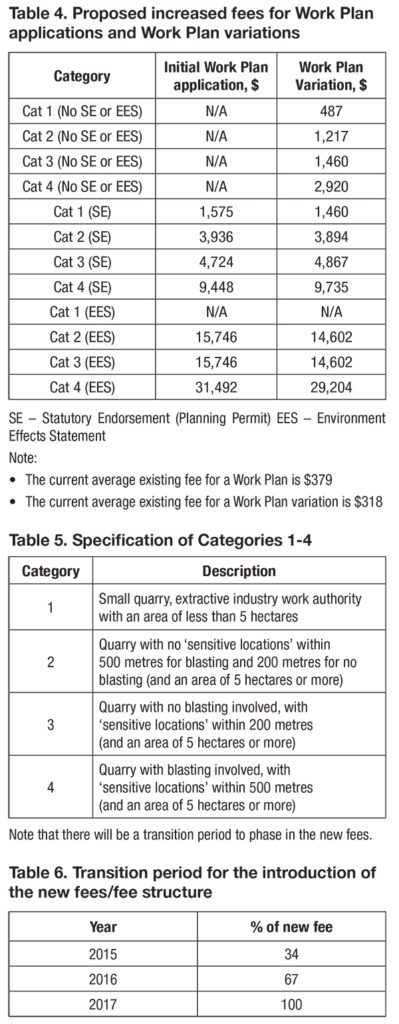CMPA Submission summary concerning proposed annual and increased Government fees
CMPA Submission to the Exposure Draft Mineral Resources (Sustainable Development) (Extractive Industries) Amendment Regulations and Regulatory Impact Statement (RIS).
THE submission was in response to the above draft Regulations and the accompanying RIS.
At the outset it is important to state the CMPA accepts the principle of full cost recovery of efficient regulatory costs where regulation is justified.
In this particular case both the level of regulation and the efficiency of the regulation are seriously questioned by the Association and its members.
Several members called the CMPA office with concerns about the impact of fees on their businesses, 10% of members were canvassed for their views about the proposed fee structure (many did not realise the significance of the letter sent by DSDBI to all stakeholders) and members had the opportunity to comment on the submission.
The submission asks the Government to honour its promises and fulfill the commitment it made in its public response to the EDIC recommendations ‘to reinvigorate the earth resources sector’ and reduce the regulatory burden in the extractive industry.
This commitment, if actioned with any degree of genuine purpose, will reduce the need for regulatory administration and, in turn, the level of cost recovery required.
Logically, once these reform actions are complete, an assessment can be made of the need for cost recoupment and how that can be undertaken simply.
The communication process from the start has by its very nature been both segregated and limited in its ability to involve all parties concerned effectively.
The submission highlights major deficiencies of the RIS (whose content is deficient) especially with respect to gross overestimation in calculation of the actual costs by 214%.
The one that most powerfully illustrates the lack of depth in the document relates to the assertion that the proposed fee structure does not impose greater costs for small operators than others.

This assertion is not founded on supporting facts so the Association has made some preliminary calculations of the impacts of the proposed annual fees based on an average of $16 per tonne of product.
This shows that a small operator will pay 407% more than the largest operator on a fee per tonne basis! As such, a new formula has been suggested in good faith that may be given consideration by DSDBI.
Inequity of the proposed fee structure
It may be argued that there is a higher cost to regulate small operators however; this is a result of complex and inefficient regulation for which the small operator should not be penalised.
The monetary value may seem low but to a small operator that operates on low margins the impact can be high. For example, a road toll on delivery of construction material may be the difference between making a profit.

CMPA Proposed formula
The following is a suggested formula for cost recovery for consideration by the department. It is understood that with respect to Work Authorities, Work Plans and Work Plan variations there is a user pays principal as per table 5.1 in the RIS. the balance of recovery should be a flat rate of say $400 then at >10,000 t per annum (this figure is already supplied to DSDBI as annual returns) apply a surcharge of $0.01/t.

This formula is:
• more equitable;
• more stable in light of market fluctuations; and
• simpler to track and administer.
In conclusion
CMPA trusts that the consultations on the draft Regulations and the RIS will result in a moratorium being placed on action on cost recovery until after the committed reforms have been completed.
At that time it is hoped that a thorough and professional analysis will be undertaken of any proposed cost recovery fee structure. The Association is prepared to assist in that activity.









You must be logged in to post a comment Login